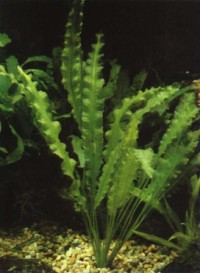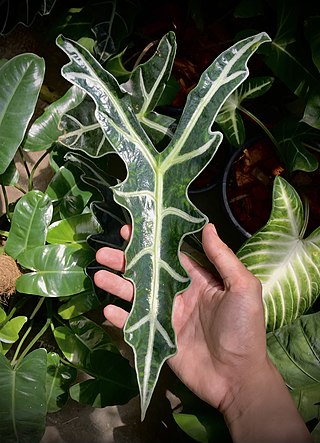
Ficus benjamina, commonly known as weeping fig, benjamin fig or ficus tree, and often sold in stores as just ficus, is a species of flowering plant in the family Moraceae, native to Asia and Australia. It is the official tree of Bangkok. The species is also naturalized in the West Indies and in the states of Florida and Arizona in the United States. In its native range, its small fruit are favored by some birds.

Cryptocoryne is a genus of aquatic plants from the family Araceae. The genus is naturally distributed in tropical regions of India, Southeast Asia and New Guinea.

Primula vulgaris, the common primrose, is a species of flowering plant in the family Primulaceae, native to western and southern Europe, northwest Africa, and parts of southwest Asia. The common name is primrose, or occasionally common primrose or English primrose to distinguish it from other Primula species also called primroses. None of these are closely related to the evening primroses.

Anubias is a genus of aquatic and semi-aquatic flowering plants in the family Araceae, native to tropical central and western Africa. They primarily grow in rivers and streams, but can also be found in marshes. They are characterized by broad, thick, dark leaves that come in many different forms. The genus was revised in 1979 and since then its nomenclature has been stable. Species can be determined by using mostly characteristics of the inflorescence. Because of the often shady places where the plants grow, the genus was named after the Egyptian god Anubis, the god of the afterlife. The genus was first described in 1857 by Heinrich Wilhelm Schott, with A. afzelii as its type species.

Echinodorus cordifolius, the spade-leaf sword or creeping burhead, is a species of aquatic plants in the Alismatales. It is native to Mexico, the West Indies, Central America, South America and the southeastern United States.

Aponogeton crispus is an aquatic plant species.

Alocasia sanderiana, commonly known as the kris plant or Sander's alocasia, is a plant in the family Araceae. It is endemic to Northern Mindanao in the Philippines, but is commonly grown as an ornamental plant worldwide. It is classified as critically endangered in the wild by the International Union for Conservation of Nature.
Aponogeton longiplumulosus is a submerged aquatic plant that is native to Madagascar. It possesses an elongated rhizome 2–3 cm in diameter. The leaves are an olive green-brown, 8 - 14 inches (20–35 cm) long and 2.5 inches (6 cm) broad, with a fluted margin and a petiole up to about 24 inches (60 cm) long. No floating leaves are formed. New leaf colour forms have been introduced recently. The flowers are a dark violet in colour.

Cryptocoryne beckettii, also known as Beckett's water trumpet, is a plant species belonging to the Araceae genus Cryptocoryne.
Cryptocoryne undulata, also known as undulate cryptocoryne, is a plant species belonging to the Araceae genus Cryptocoryne.

Cryptocoryne × willisii is a plant in the family Araceae.

Cryptocoryne wendtii, the Wendt's water trumpet, is a species of herb which is a popular aquarium plant which is native to Sri Lanka. It was described by Dutch botanist Hendrik de Wit in honour of aquarium hobbyist and writer Albert Wendt.

Aponogeton rigidifolius is a species of freshwater plant native to Sri Lanka. In the wild it grows in deep water at temperatures of 68 to 77 °F in sandy soil with the water pH at 7.2.

Nymphoides aquatica is an aquatic plant in the Menyanthaceae, native to the southeastern United States from Texas to Maryland. It is known variously as the banana plant, banana lily, and the big floatingheart. It is most commonly called the banana plant because of its banana-shaped roots. These unusual roots store nutrients.
Cryptocoryne aponogetifolia is a species belonging to the Araceae genus Cryptocoryne.
Cryptocoryne auriculata is a plant species belonging to the Araceae genus Cryptocoryne.

Oxalis triangularis, commonly called false shamrock, is a species of perennial plant in the family Oxalidaceae. It is native to several countries in southern South America. This woodsorrel is typically grown as a houseplant but can be grown outside in USDA climate zones 8a–11, preferably in light shade.
× Heucherella is an evergreen perennial flowering plant in the family Saxifragaceae. A hybrid of garden origin, it is the result of a cross between two distinct genera, Heuchera and Tiarella, and shows similarities to both parents. This type of intergeneric hybrid is quite rare, and is indicated by a multiplication symbol before the name. The name Heucherella is an example of a portmanteau word, a combination of the two parents' names.

Roscoea cautleyoides is a perennial herbaceous plant occurring in the Sichuan and Yunnan provinces of China. The scientific name is also spelt Roscoea cautleoides. Most members of the ginger family (Zingiberaceae), to which it belongs, are tropical, but R. cautleyoides, like other species of Roscoea, grows in much colder mountainous regions. It is sometimes grown as an ornamental plant in gardens.
Cryptocoryne parva is an aquatic freshwater plant, often grown in aquariums. It is the smallest known member of the genus Cryptocoryne. Native to Sri Lanka, it grows as a small rosette reaching between 5 - 8 cm. Emersed leaves are a little wider than those growing under water. The spathe is c. 1.5 cm.













